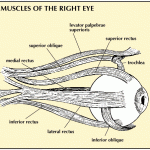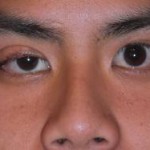Ptosis (from Greek Ptosis or πτῶσις, to “fall”) is a drooping or falling of the upper or lower eyelid. The drooping may be worse after being awake longer, when the individual’s muscles are tired. This condition is sometimes called “lazy eye”, but that term normally refers to amblyopia. If severe enough and left untreated, the drooping eyelid can cause other conditions, such as amblyopia or astigmatism. This is why it is especially important for this disorder to be treated in children at a young age, before it can interfere with vision development.
A drooping eyelid can stay constant, worsen over time (progressive), or come and go (intermittent). It can be one-sided or on both sides. When drooping is one-sided (unilateral), it is easier to be detected by comparing the two eyelids. Drooping is more difficult to detect when it occurs on both sides, or if there is only a slight problem.
A furrowed forehead or a chin-up head position may indicate that someone is trying to see under their drooping lids. Eyelid drooping can make someone appear sleepy or tired.
Drooping lids are either present at birth (congenital) or develop later in life. A drooping eyelid is not a reason to panic, but you should report it to your doctor.
Etymology
Ptosis is derived from the Greek wording (πτῶσις) “fall,†and is defined as the “abnormal lowering or prolapse of an organ or body part.”
Causes
Both eyelids drooping:
- Medical problem, such as myasthenia gravis
- Migraine headaches
- Normal aging process
- Normal variation of the eyelids
One eyelid drooping:
- Growth in the eyelid, such as a stye
- Medical problem
- Nerve injury
- Normal aging process
- Normal variation
 Ptosis occurs when the muscles that raise the eyelid (levator and Müller’s muscles) are not strong enough to do so properly. It can affect one eye or both eyes and is more common in the elderly, as muscles in the eyelids may begin to deteriorate. One can, however, be born with ptosis. Congenital ptosis is hereditary in three main forms. Causes of congenital ptosis remain unknown. Ptosis may be caused by damage/trauma to the muscle which raises the eyelid, damage to the superior cervical sympathetic ganglion or damage to the nerve (3rd cranial nerve (oculomotor nerve)) which controls this muscle. Such damage could be a sign or symptom of an underlying disease such as diabetes mellitus, a brain tumor, a pancoast tumor (apex of lung) and diseases which may cause weakness in muscles or nerve damage, such as myasthenia gravis. Exposure to the toxins in some snake venoms, such as that of the black mamba, may also cause this effect.
Ptosis occurs when the muscles that raise the eyelid (levator and Müller’s muscles) are not strong enough to do so properly. It can affect one eye or both eyes and is more common in the elderly, as muscles in the eyelids may begin to deteriorate. One can, however, be born with ptosis. Congenital ptosis is hereditary in three main forms. Causes of congenital ptosis remain unknown. Ptosis may be caused by damage/trauma to the muscle which raises the eyelid, damage to the superior cervical sympathetic ganglion or damage to the nerve (3rd cranial nerve (oculomotor nerve)) which controls this muscle. Such damage could be a sign or symptom of an underlying disease such as diabetes mellitus, a brain tumor, a pancoast tumor (apex of lung) and diseases which may cause weakness in muscles or nerve damage, such as myasthenia gravis. Exposure to the toxins in some snake venoms, such as that of the black mamba, may also cause this effect.
Ptosis can be caused by the aponeurosis of the levator muscle, nerve abnormalities, trauma, inflammation or lesions of the lid or orbit. Dysfunctions of the levators may occur as a result of a lack of nerve communication being sent to the receptors due to antibodies needlessly attacking and eliminating the neurotransmitter.
Ptosis may be due to a myogenic, neurogenic, aponeurotic, mechanical or traumatic cause and it usually occurs isolated, but may be associated with various other conditions, like immunological, degenerative, or hereditary disorders, tumors, or infections.
Acquired ptosis is most commonly caused by aponeurotic ptosis. This can occur as a result of senescence, dehiscence or disinsertion of the levator aponeurosis. Moreover, chronic inflammation or intraocular surgery can lead to the same effect. Also, wearing contact lenses for long periods of time is thought to have a certain impact on the development of this condition.
Congenital neurogenic ptosis is believed to be caused by the Horner syndrome. In this case, a mild ptosis may be associated with ipsilateral ptosis, iris and areola hypopigmentation and anhidrosis due to the paresis of the Mueller muscle. Acquired Horner syndrome may result after trauma, neoplastic insult, or even vascular disease.
Ptosis due to trauma can ensue after an eyelid laceration with transection of the upper eyelid elevators or disruption of the neural input.
Other causes of ptosis include eyelid neoplasms, neurofibromas or the cicatrization after inflammation or surgery. Mild ptosis may occur with aging.
Drugs
Use of high doses of opioid drugs such as morphine, oxycodone or hydrocodone can cause ptosis, and it is a side effect commonly seen in the abuse of drugs such as diacetylmorphine (heroin). Pregabalin (Lyrica) has also been known to cause mild ptosis.
Classification
 Depending upon the cause it can be classified into:
Depending upon the cause it can be classified into:
- Neurogenic ptosis which includes oculomotor nerve palsy, Horner’s Syndrome, Marcus Gunn jaw winking syndrome, Third cranial nerve misdirection.
- Myogenic ptosis which includes myasthenia gravis, myotonic dystrophy, ocular myopathy, simple congenital ptosis, blepharophimosis syndrome
- Aponeurotic ptosis which may be involutional or post-operative.
- Mechanical ptosis which occurs due to edema or tumors of the upper lid
- Neurotoxic ptosis which is a classic symptom of envenomation by elapids such as cobras, or kraits. Bilateral ptosis is usually accompanied by diplopia, dysphagia and/or progressive muscular paralysis. Regardless, neurotoxic ptosis is a precursor to respiratory failure and eventual suffocation caused by complete paralysis of the thoracic diaphragm. It is therefore a medical emergency and immediate treatment is required.
- pseudo ptosis due to:1-Lack of lid support: Empty socket or atrophic globe. 2-Higher lid position on the other side: As in     lid retraction

